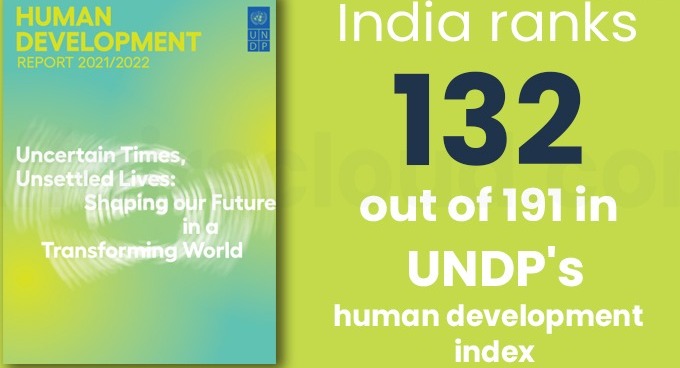India ranks 132 out of 191 countries in UNDP’s Human Development Index
The United Nations Development Programme (UNDP) recently released its Human Development Index (HDI) 2020 report, which ranks countries based on their human development levels. According to the report, India has been ranked 132 out of 191 countries, with an HDI value of 0.645. India’s HDI value has increased from 0.640 in 2019, but the country’s ranking has remained unchanged from the previous year.

Why this News is Important
This news is important for students preparing for government exams, as it highlights India’s position on the Human Development Index and its progress towards achieving sustainable human development. The HDI is an important parameter used by various government and non-government organizations to measure a country’s overall well-being and development. Moreover, the HDI score is also an important parameter used by international organizations, such as the World Bank and the International Monetary Fund, to determine a country’s eligibility for loans and grants.
India’s Historical Context
India has made significant progress in terms of human development over the past few decades. Since independence, the country has implemented various policies and programs aimed at reducing poverty, improving healthcare, and increasing access to education. According to the HDI report, India’s HDI value has increased by 0.188 since 1990, which is higher than the average increase of countries in South Asia (0.150). However, despite this progress, India still faces several challenges, including income inequality, gender disparity, and inadequate healthcare infrastructure.
5 Key Takeaways from “India ranks 132 out of 191 countries in UNDP’s Human Development Index”
| Serial No. | Key Takeaway |
|---|---|
| 1 | India has been ranked 132 out of 191 countries in the Human Development Index 2021 report. |
| 2 | India’s HDI value has increased from 0.640 in 2019 to 0.645 in 2020. |
| 3 | The HDI score is an important parameter used by various government and non-government organizations to measure a country’s overall well-being and development. |
| 4 | India has made significant progress in terms of human development since independence. |
| 5 | Despite this progress, India still faces several challenges, including income inequality, gender disparity, and inadequate healthcare infrastructure. |
Conclusion
In conclusion, India’s ranking of 132 out of 191 countries in the Human Development Index 2020 report is an indication that the country still has a long way to go in terms of achieving sustainable human development. This news highlights the need for the government to implement policies and programs aimed at reducing poverty, improving healthcare, and increasing access to education. For students preparing for government exams, it is important to be aware of India’s HDI ranking and the progress made by the country towards achieving sustainable human development.
Important FAQs for Students from this News
Q: What is the Human Development Index (HDI)?
A: The Human Development Index (HDI) is a measure of a country’s well-being and development, which takes into account factors such as life expectancy, education, and income.
Q: What is India’s ranking in the Human Development Index 2020 report?
A: India has been ranked 132 out of 191 countries in the Human Development Index 2021 report.
Q: Has India’s HDI value improved from the previous year?
A: Yes, India’s HDI value has increased from 0.640 in 2019 to 0.645 in 2020.
Q: What are some of the challenges faced by India in terms of human development?
A: Some of the challenges faced by India in terms of human development include income inequality, gender disparity, and inadequate healthcare infrastructure.
Q: Why is the HDI score important for countries?
A: The HDI score is important for countries as it is used by various government and non-government organizations to measure a country’s overall well-being and development.
Some Important Current Affairs Links















